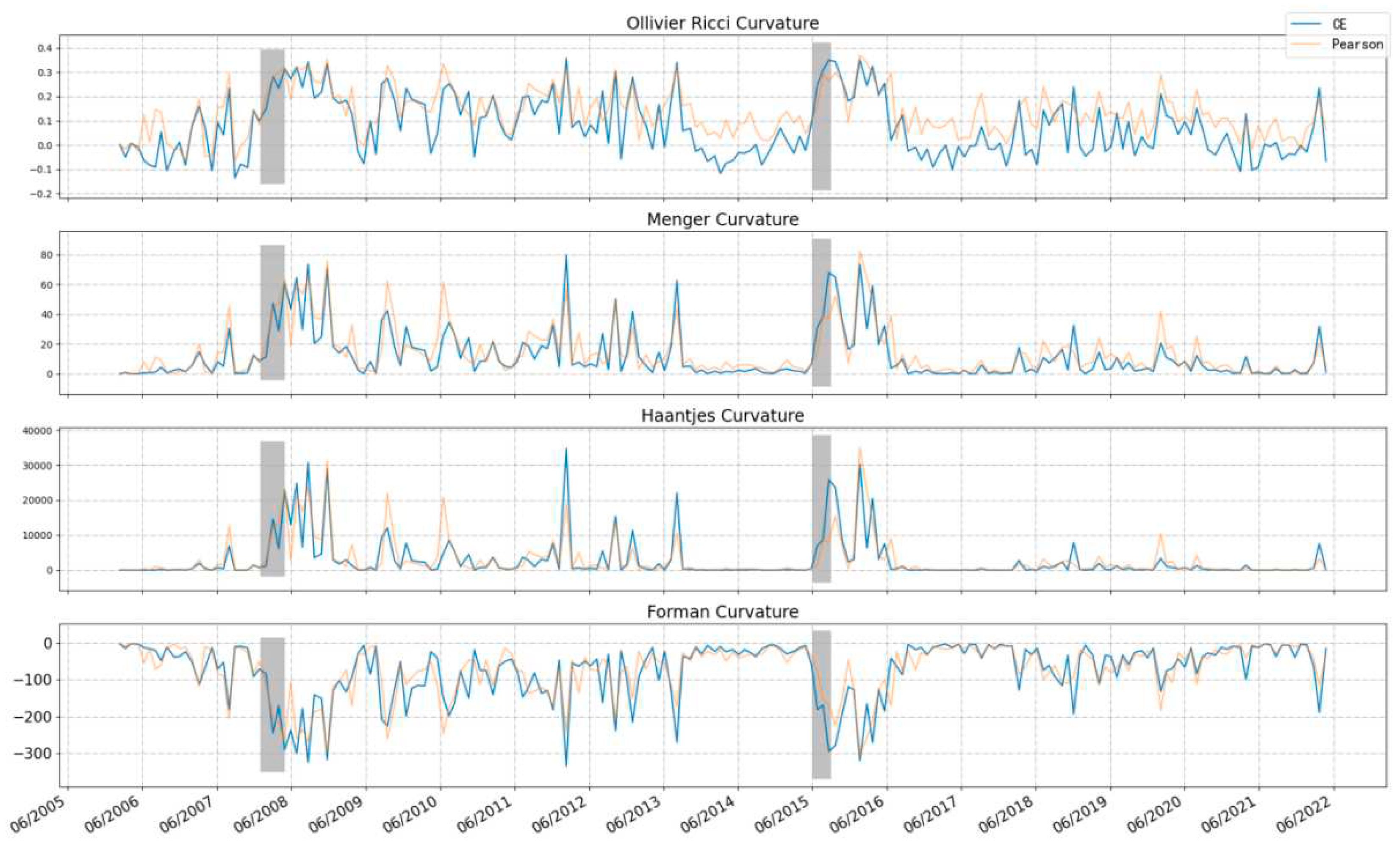Submitted:
22 August 2023
Posted:
22 August 2023
You are already at the latest version
Abstract
Keywords:
1. Introduction
2. Copula entropy and Ricci curvature
2.1. Nonlinear causal and information captured with Copula entropy
2.2. Market vulnerability measurement with Ricci curvature
3. The calculation of curvature
4. Empirical results and analyses
4.1. CE and correlation coefficient
4.2. Network analysis with CSI 300 component stocks
4.3. Comparison with traditional risk metrics
5. Conclusions
Author Contributions
Funding
Data Availability Statement
Conflicts of Interest
Appendix A
References
- Minsky Ph D H, P. The financial-instability hypothesis: capitalist processes and the behavior of the economy; 1982.
- Kaminsky G; Lizondo S, Reinhart C M. Leading indicators of currency crises. Staff Papers, 1998, 45(1), pp. 1-48.
- Billio M, Casarin R; Costola M, et al. An entropy-based early warning indicator for systemic risk. Journal of International Financial Markets, Institutions and Money, 2016, 45, pp. 42-59.
- Battiston S; Puliga M; Kaushik R, et al. Debtrank: Too central to fail? financial networks, the fed and systemic risk. Scientific reports, 2012, 2(1), pp. 1-6.
- Haldane A G; May R M. Systemic risk in banking ecosystems. Nature, 2011, 469(7330), pp. 351-355.
- Mantegna R, N. Hierarchical structure in financial markets. The European Physical Journal B-Condensed Matter and Complex Systems, 1999, 11, pp. 193–197. [Google Scholar] [CrossRef]
- Onnela J P; Chakraborti A; Kaski K, et al. Dynamics of market correlations: Taxonomy and portfolio analysis. Physical Review E, 2003, 68(5), pp. 056110.
- Sandhu R; Georgiou T; Tannenbaum A. Market fragility, systemic risk, and Ricci curvature. arXiv preprint arXiv:1505.05182, 2015. arXiv:1505.05182, 2015.
- Ma, J.; Sun, Z. Dependence Structure Estimation via Copula. CoRR, 2008, abs/0804.4451.
- Sklar, M. Fonctions de repartition an dimensions et leurs marges. Publ. inst. statist. univ. Paris, 1959, 8, pp. 229–231. [Google Scholar]
- Ma J; Sun Z. Mutual information is copula entropy. Tsinghua Science & Technology, 2011, 16(1), pp. 51-54.
- Li, Y.L.; Gong, Y.J. Research on LSTM drought prediction model based on drive analysis. Journal of Mathematics in Practice and Theory, 2022, pp. 1-11.
- Spearman, C. The american journal of psychology. American Journal of Psychology, 1904, 15, pp 88. [Google Scholar]
- Kraskov A; Stögbauer H; Grassberger P. Estimating mutual information. Physical review E, 2004, 69(6): 066138.
- Samal A; Pharasi H K; Ramaia S J, et al. Network geometry and market instability. Royal Society Open Science, 2021, 8(2), 201734.
- De Long J B; Shleifer A; Summers L H, et al. Positive feedback investment strategies and destabilizing rational speculation. The Journal of Finance, 1990, 45(2), pp. 379-395.
- Stambaugh R F; Yu J; Yuan Y. Arbitrage asymmetry and the idiosyncratic volatility puzzle. The Journal of Finance, 2015, 70(5), pp. 1903-1948.
- Sandhu R S; Georgiou T T; Tannenbaum A R. Ricci curvature: An economic indicator for market fragility and systemic risk. Science advances, 2016, 2(5): e1501495.
- Sreejith R P; Mohanraj K; Jost J, et al. Forman curvature for complex networks. Journal of Statistical Mechanics: Theory and Experiment, 2016(6): 063206.
- Saucan E; Samal A; Jost J. A simple differential geometry for complex networks. Network Science, 2021, 9(S1), pp. S106-S133.
- Saucan E; Samal A; Jost J. A simple differential geometry for networks and its generalizations. Complex Networks and Their Applications VIII: Volume 1 Proceedings of the Eighth International Conference on Complex Networks and Their Applications COMPLEX NETWORKS 2019 8. Springer International Publishing, 2020, pp. 943-954.





| OR | MR | HR | FR | ORP | EVOL | VOL | ||
| OR | 1 | |||||||
| MR | 0.8840*** | 1 | ||||||
| (0.0000) | ||||||||
| HR | 0.7445*** | 0.9613*** | 1 | |||||
| (0.0000) | (0.0000) | |||||||
| FR | -0.9354*** | -0.9792*** | -0.8936*** | 1 | ||||
| (0.0000) | (0.0000) | (0.0000) | ||||||
| ORP | 0.5249*** | 0.5285*** | 0.4579*** | -0.5342*** | 1 | |||
| (0.0000) | (0.0000) | (0.0000) | (0.0000) | |||||
| EVOL | 0.5861*** | 0.6187*** | 0.5477*** | -0.6376*** | 0.7975*** | 1 | ||
| (0.0000) | (0.0000) | (0.0000) | (0.0000) | (0.0000) | ||||
| VOL | 0.6215*** | 0.6596*** | 0.5939*** | -0.6720*** | 0.8225*** | 0.9089*** | 1 | |
| (0.0000) | (0.0000) | (0.0000) | (0.0000) | (0.0000) | (0.0000) |
Disclaimer/Publisher’s Note: The statements, opinions and data contained in all publications are solely those of the individual author(s) and contributor(s) and not of MDPI and/or the editor(s). MDPI and/or the editor(s) disclaim responsibility for any injury to people or property resulting from any ideas, methods, instructions or products referred to in the content. |
© 2023 by the authors. Licensee MDPI, Basel, Switzerland. This article is an open access article distributed under the terms and conditions of the Creative Commons Attribution (CC BY) license (http://creativecommons.org/licenses/by/4.0/).




